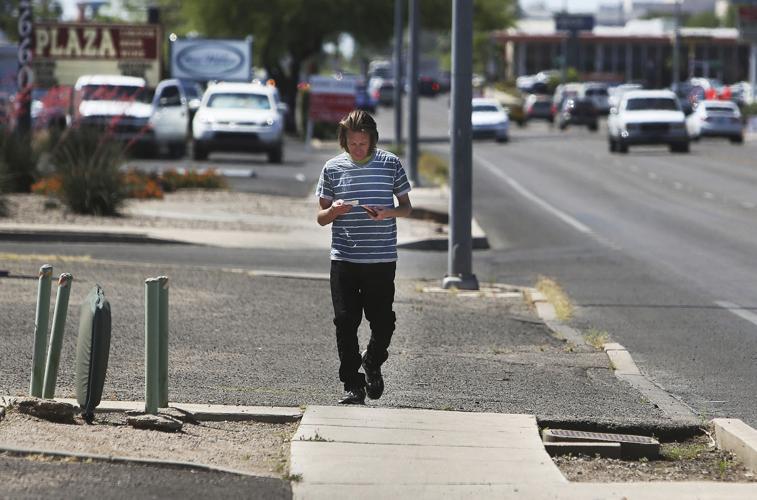Being 21st-century Tucsonans, my son and I decided to bike the five miles to the UA’s Sept. 10 football game against Grambling State.
But a red light at North Alvernon Way and East Third Street turned the bike jaunt into a journey along Tucson’s 19th-century pedestrian infrastructure.
When the light turned green, I put all my weight on one pedal of my borrowed one-speed. The chain snapped.
With that, we started walking. First we locked up the bikes at Alvernon and East Fifth Street, then we headed west on Fifth, thinking we’d catch a bus before we made it far along the two-plus miles to the stadium. Unfortunately, the Route 3 bus snuck up and passed us as we walked between stops.
It turned into an unwanted adventure that thousands and thousands of Tucsonans have also experienced over the years. Even along East Fifth Street west of North Alvernon Way — an artery into the heart of midtown — the path takes a familiar turn. The sidewalk quickly turns into a gravel path, turns into a slanted driveway, turns into a weedy morass, turns into a cactus jungle, turns into a sidewalk just one property wide. And so on.
Never having walked this stretch before, I was a bit surprised it was that bad. But having lived in Tucson for almost 20 years, not very. Our roads here may be of questionable quality, but our sidewalks and other pedestrian infrastructure are not just questionable — they’re poor.
That’s an inheritance of the haphazard way the city developed, often leapfrogging the city limits to avoid requirements such as sidewalks. But it’s one we ought to deal with now.
Fortunately, I’m not the first person to think of this. We have been putting in some sidewalks along busy roads, paid for by the 10-year-old half-cent sales tax that funds the countywide Regional Transit Authority. But most of that money is dedicated to roads and transit.
The most desperate need is in the city proper, where the population is densest and the sidewalk situation most mind-boggling.
Vanessa Cascio, the chair of the city’s pedestrian advisory committee, recognized the problem when she left Tucson, her hometown, and lived 10 years in Chicago only to return to live here.
“I lived in Chicago for about a decade, never owned a vehicle. I was able to have a different kind of life that I found challenging when I got back here,” she said. “Walkability is integral to our quality of life — having accessibility to safe and comfortable walking spaces.”
In Tucson, the safety and comfort of walking at night will always be in some question. Our dark skies ordinance keeps the city dark at night in the name of preserving astronomy.
Just the day after my misadventure on East Fifth Street, I was walking my dogs along the edge of a sidewalk-free neighborhood corner when a vehicle made a sharp turn and missed us by maybe five feet. It wasn’t that close, but it was a reminder of how unsafe the city can be for walkers at night.
Lights would have made that situation safer, but they’re not necessary. Sidewalks would have done it.
Two current initiatives could bring Tucson more sidewalks, though paying for them is a challenge.
As my colleague Murphy Woodhouse reported, the city is developing a pedestrian safety action plan. That’s an effort to cut down on pedestrian deaths which, if you haven’t noticed, are high in Tucson.
Separately, consultants are doing work that has the potential to give us a lever to ratchet out money to build sidewalks. They’re doing a new inventory of city sidewalks in light of compliance with the Americans with Disability Act. This “ADA transition plan” should be out at the October meeting of the Pedestrian Advisory Committee, said Ann Chanecka, the city’s bicycle and pedestrian program coordinator.
They spent a year inventorying every square mile of right of way and its compliance with ADA. Suffice it to say the city is vastly out of compliance, though it has retrofitted when required, by putting in wheelchair ramps every time it repaves streets.
Maybe this data will help us get grants to install sidewalks that are ADA compliant, so we don’t have so many scooters shuttling down bike lanes.
Or maybe we’ll have to do it ourselves.
City Council member Steve Kozachik pointed out in a Sept. 11 guest opinion in the Star that we are nearing the end of our five-year road bond program, and that it has proven so positive we should consider doing it again.
I agree, but maybe this time we should include money for that most-lacking element of our local infrastructure — sidewalks.





